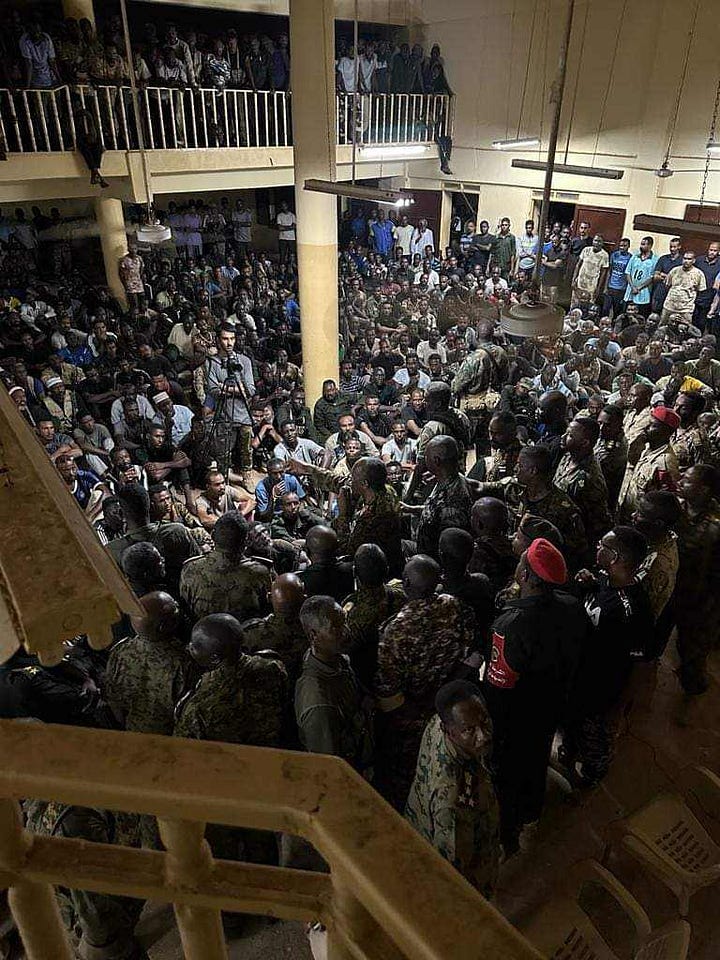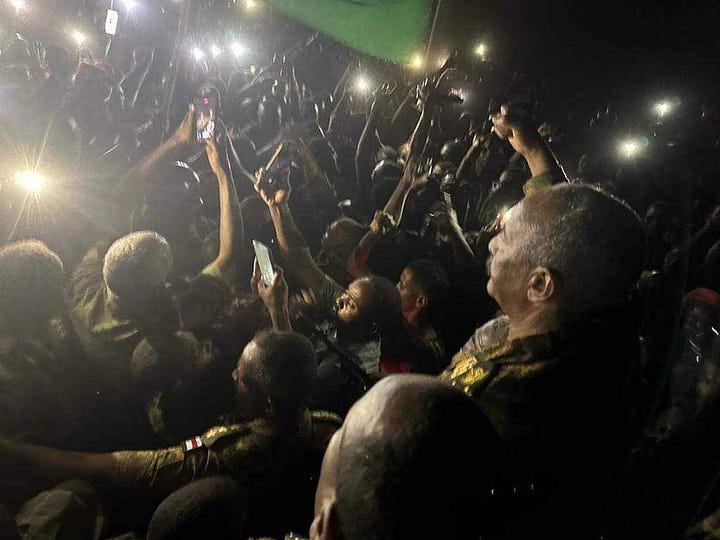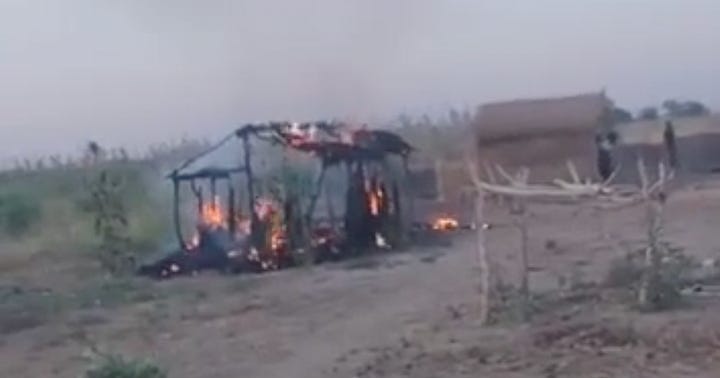Fall of Nyala and Zalingei garrisons closes one chapter and opens another in new Darfur war
RSF victories could bring respite from conflict in some areas, escalate it in others
ANALYSIS
The Rapid Support Forces captured the 21st Infantry Division headquarters in Zalingei, the capital of Central Darfur, during the night Tuesday, October 31, after the defenders abandoned the base.
This comes just over a day after they captured the 16th Infantry Division in Nyala, which fell after a long siege, defections, and desertions of some of the defenders, followed by a final assault in which dozens were killed.
In the meantime, reports from al-Geneina suggest the possibility of a negotiated surrender there, brokered by local tribal leaders, or a major attack on the garrison.
This would leave only one SAF garrison in the Darfur region, in al-Fasher, where intermittent clashes and RSF drone attacks took place late Tuesday. (Nominally, SAF still have forces in ad-Daien and Buram, but these forces seem to be on good terms with the RSF and unwilling or unable to fight). According to a local source, some residents of al-Fasher are leaving the town because they are expecting an attack by the RSF.
Garrisons throughout Kordofan have also come under attack, and many have fallen. RSF captured the Baleela airport yesterday, shutting down Baleela oilfield in West Kordofan, and they clashed with the army inside the North Kordofan capital yesterday.
Hence, with the close of October, the seventh month of the war, major garrisons have fallen throughout western Sudan. Previously, the RSF had captured army outposts and border posts in smaller towns throughout Darfur, but not the larger garrisons.
What’s next for Darfur?
In the short term, RSF’s capture of Nyala could bring some humanitarian relief as the majority of residents will be able to move more freely without fear of shelling, cross-fire, and aerial bombardments. Speaking with Radio Tamazuj, Nyala residents expressed relief at the end of the fighting. But there are also reports of some displacement from Nyala, in addition to the tens of thousands who already left.
In Zalingei, there is a substantial risk of continuing clashes between RSF and SAF remnants, as well as SLA factions and other armed groups in and around the displaced camps and in the countryside. The RSF have been blocking supplies to the Hassa Hissa IDP camp for several weeks. The residents of the camp are majority ethnic Fur, and the RSF are majority Arab, giving this conflict an ethnic character.
In the medium to longer term, RSF’s victories do not mean the region will necessarily stabilize. The paramilitary’s control over Darfur is fractious and incomplete. Large areas are occupied by former Darfur rebel factions (which are hitherto neutral), as well as tribal militias. Relations between RSF and the former rebels remain generally stable, though increasingly tense, after RSF fighters killed some members in Nyala.
Internally, the RSF face the challenges of keeping their forces united, supplied, and fed, which will be difficult without a common enemy to fight and plunder. Thousands of RSF fighters are likely to redeploy to other theaters of the war, while others will remain behind in Darfur, where there is growing hunger and lawlessness.
For its part, SAF can now concentrate its efforts on defending al-Fasher, where they recently graduated thousands of new recruits. Although SAF have lost control over most of the Darfur region, they will likely attempt to work through proxies to undermine RSF’s hold in the region.
This was the army’s strategy during the 23-year war in South Sudan, when it lost control of large parts of the region but delivered weapons and supplies to enemies of the SPLA, including the Lord’s Resistance Army, SSUM/A of Paulino Matip, and others.
Political fallout
Politically, the timing of these attacks, coinciding with the resumption of the Jeddah talks, suggests the RSF leadership believe they gain some political advantage from them. “Through this victory, the RSF has further advanced its strategic position in this war…” the RSF spokesperson said in a statement Tuesday.
In reality, the RSF have gained very little either domestically or internationally.
Internationally, the facilitators of the Jeddah talks (the United States and Saudi Arabia) have made clear they do not recognize the RSF as a legitimate government, nor will they. Domestically, few if any Sudanese political parties, unions, or civil society support the RSF war or the idea of an RSF-led government.
Concretely, the only thing the RSF gain from these attacks is more loot and weapons, in cities with shattered economies and health systems, hungry and frightened populations, and growing lawlessness.
Granted, the RSF’s victories could put more pressure on the SAF delegation in Jeddah to bend to RSF demands. But the nature of the Jeddah talks is very limited—focusing just on humanitarian access, a ceasefire, “confidence-building measures” (such as release of prisoners of war), and the possibility of a permanent cessation of hostilities.
“Concretely, the only thing the RSF gain from these attacks is more loot and weapons, in cities with shattered economies and health systems, hungry and frightened populations, and growing lawlessness.”
The Jeddah platform does not provide a means through which the RSF can achieve its ambitions. Many members of the RSF continue to believe in a military solution.
Abdelrahim Dagalo, RSF’s deputy commander-in-chief, made a speech Tuesday, saying, “Don’t say the army is strong, don’t say the army is ready, don’t say the army is fighting. They aren’t fighting. Right now you are defending from the basement of the General Command, and daily we are advancing. We will capture it from you, God willing. And we are knocking on the door of Wadi Saidna.” Dagalo had arrived in Zalingei on Monday, along with reinforcements from Nyala.
Likewise, many SAF leaders, as well as the rank-and-file, oppose the possibility of a ceasefire agreement. The RSF’s recent Darfur offensive may have hardened opposition to a potential agreement in Jeddah—or limited its likely impact.
SAF commander-in-chief Abdel Fattah al-Burhan visited Wadi Saidna on Tuesday night, October 31, where he rallied troops and downplayed the importance of the Jeddah negotiations: “What has just happened in Darfur shows that those people (RSF) do not want peace, and do not want negotiations, and don’t want anything that will allow the country to move forward.”


Details of the Zalingei attack
The fate of SAF’s soldiers in Zalingei is unclear at this point. The number of defenders had already been dwindling due to a months-long siege. There weren’t any bodies in the videos filmed by RSF at the base this morning, nor were there any combat videos. Intermittent gunfire is heard in some videos, but this may have been celebratory.
These factors suggest that the base fell without a fight, or with minimal fighting.
As early as 02:00, the RSF Sector Commander in Central Darfur Ali Yagoub Jibril recorded a speech announcing the fall of the base. He said that they captured the division commander, 50 senior officers, and “hundreds of soldiers.” However, this is likely very exaggerated; Jibril has a prior history of making false claims.
Although some officers and men probably surrendered or were captured, others may have slipped away into civilian areas, such as the nearby IDP camps. If this is the case, the RSF may target these camps and enhance its ongoing abuses against civilians in and around the camps. There are no nearby SAF-controlled territories where the defenders could retreat to. The only possibility is Jebel Marra, a territory controlled by SLA-AW. However, this is a journey of more than a day by foot, and SAF and SLA-AW have not concluded any peace deal, in spite of high-level contacts.
An Antonov aircraft belonging to SAF dropped ammunition and supplies to the Zalingei forces early Tuesday morning, but the drop was either timed wrongly or misplaced. The RSF captured at least some of those supplies, as seen in this video.
Abdel-Rahim Dagalo mentioned the airdrop in his speech, mocking al-Burhan, saying, “Even if you manage to deliver them, how many are there? 20 packages? But luckily we managed to receive them from air.”
In brief
The International Committee of the Red Cross (ICRC) on Monday facilitated the release of 64 SAF detainees who had been held by the RSF. “The released persons were transported from Khartoum to Wad Madani… Since the fighting erupted in April, the ICRC has facilitated the release and transfer of 292 persons detained in relation to the conflict in Sudan,” ICRC said in a press statement.
The second in command of SAF’s of the 22nd Infantry Division (Babanusa), Brigadier Khaled al-Fadil, died in the attack and Balila yesterday, according to visual confirmation. This is in addition to the casualties we reported yesterday.
The attack on Balila happened a day after an aircraft arrived from Kenana carrying reinforcements from Sinja, about 60 in total, according to a recorded video of a prisoner of war captured at the airport. The total size of the force at Baleela was 300, with three tanks, according to another POW interview. That is equivalent to the size of a battalion in the Sudanese system.
SAF and RSF clashed Tuesday, October 31, north of Jebel Aulia, a city southwest of Khartoum, according to social media reports. SAF control most of the city but RSF are present in some northern and eastern outskirts and agricultural areas.
SAF heavily bombed the RSF’s Taiba camp, north of Jebel Aulia, on the evening of October 27, immediately after the fall of the Nyala garrison. It’s not clear if RSF were using the camp at the time that it was bombed.
Citing a Red Crescent source, Radio Tamazuj reported that volunteers on Sunday buried 41 bodies after the battle of the 16th Division headquarters in Nyala, and said there were still more bodies to bury. Most of these likely were from the SAF side, since RSF likely handled burial of their own dead.
The Joint Force (Juba Signatories) have issued a statement denying that they withdrew their forces from Nyala after the fall of the 16th Division. The statement was in response to a viral video of dozens of civilian cars, escorted by Joint Force combat vehicles, en route from Nyala. The statement confirmed, however, that the Joint Force assigned an escort of 15 combat vehicles to evacuate civilians to Labdo, Muhajiriya, and Ladoub, with al-Fasher being the final destination.
RSF capture Gurdud Nyami and SAF withdraw from Kharasana


Last week, the RSF captured an outpost at Gurdud Nyami, a remote area north of the Nuba Mountains, located on the border between North and South Kordofan States. Celebrations were reported after this attack October 24 in the RSF-controlled town of Um Ruwaba. The below video is graphic, with one body.
Additionally, the army has withdrawn from the Kharasana area in West Kordofan. The below video shows buildings burning at the army base in the village on an unknown date. The person recording it says the local citizens set fire to it after the army withdrew. The forces present at Kharasana may have joined up with SAF-affiliated oil police at Diffra in northern Abyei.


